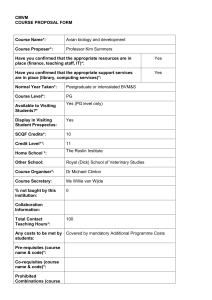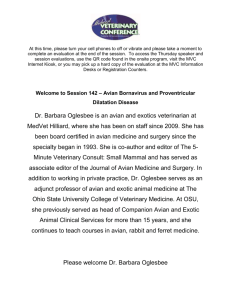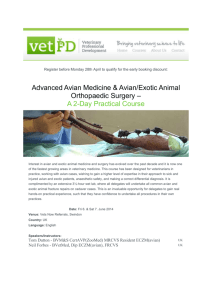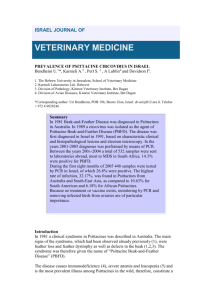Avian Health
advertisement
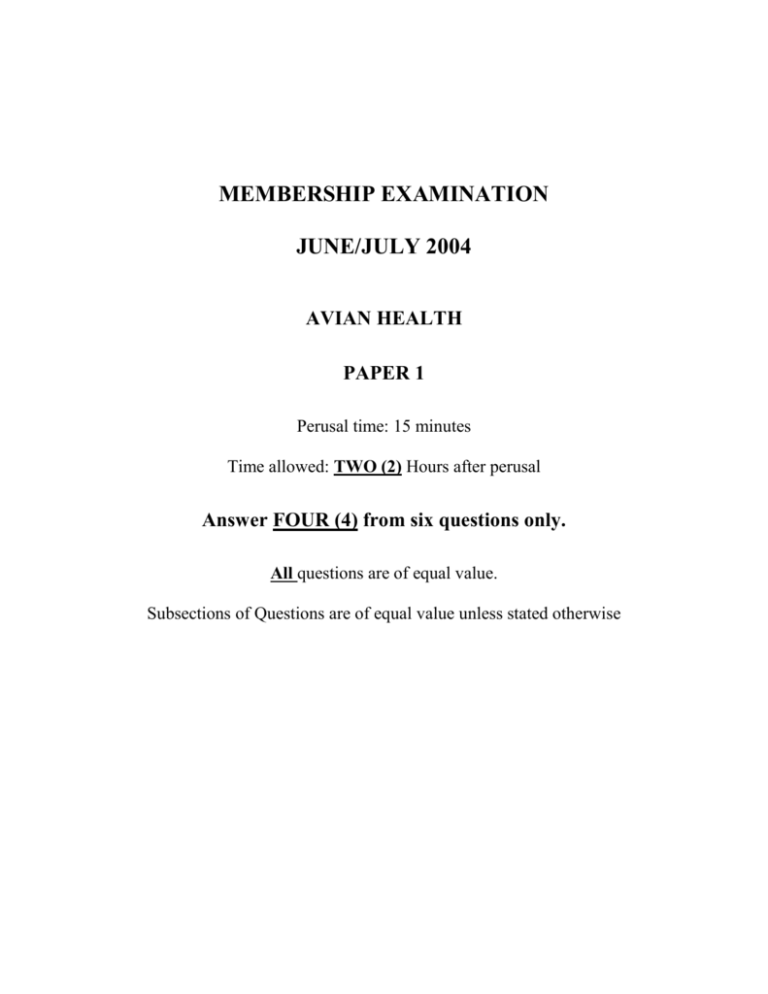
MEMBERSHIP EXAMINATION JUNE/JULY 2004 AVIAN HEALTH PAPER 1 Perusal time: 15 minutes Time allowed: TWO (2) Hours after perusal Answer FOUR (4) from six questions only. All questions are of equal value. Subsections of Questions are of equal value unless stated otherwise PAPER ONE – AVIAN HEALTH - 2004 Answer FOUR (4) from six questions only. 1. Describe and/or illustrate the anatomy of FOUR (4) of the following: a. b. c. d. e. 2. Discuss the pharmacology and use of FOUR (4) of the following drugs: a. b. c. d. e. 3. Skeletal anatomy of the pelvic limb of a psittacine. The avian kidney. The feather and its follicle. Nasal cavity and infra-orbital sinuses of a psittacine. The male reproductive tract of a waterfowl. Dimetronidazole in psittacines and passerines. Meloxicam in birds. Dexamethasone in birds. GnRH agonists in cockatiels. Cefotaxime in birds. Discuss the use and application of FOUR (4) of the following in birds: a. b. c. d. e. f. Haematology Chlamydophila and circovirus PCR probes Protein electrophoresis Urea and uric acid Faecal examination, including wet smears, flotation and cytology Endoscopy 4. Discuss the handrearing of an artificially-incubated psittacine chick. Your answer should include reference to its management, diet, and feeding techniques. List SIX (6) possible neonatal and paediatric problems that you could commonly expect to encounter in a nursery. 5. Describe the post mortem findings of THREE (3) of the following diseases: a. b. c. d. 6. Zinc toxicosis in Parrots. Aspergillosis in a waterfowl. Chlamydiosis in a psittacine. Atoxoplasmosis in a canary. Describe the husbandry of a pet bird of your choice. Your answer should include (but not be limited to) references to diet, caging, and environmental enrichment. END OF PAPER MEMBERSHIP EXAMINATION JUNE/JULY 2004 AVIAN HEALTH PAPER 2 Perusal time: 15 minutes Time allowed: TWO (2) Hours after perusal Answer FOUR (4) from six questions only. All questions are of equal value. Subsections of Questions are of equal value unless stated otherwise PAPER TWO – AVIAN HEALTH - 2004 Answer FOUR (4) from six questions only. 1. List and discuss the neurological disease syndromes seen in Australian birds both in captivity and the wild. 2. Discuss the management of THREE (3) of the following wounds: a. b. c. d. e. 3. Crop fistula in a young cockatoo. Acute self-mutilation of the skin over the tibiotarsus. Self-mutilation of the prepatagial membrane in Agapornis spp. Sternal mutilation following crash injuries in a galah. Laceration on the keel of a goose after a dog attack. Discuss the clinical significance and possible treatment of THREE (3) of the following: a. Motile protozoa in a faecal smear of an Australian King Parrot (Alisterus scapularis). A sick fledgling African Grey Parrot (Psittacus erithacus) with a severe leucopaenia (<2 x 109/L) and a non-regenerative anaemia (haematocrit 10-25%). A 5 year old domestic fowl (Gallus gallus) hen with a fluid-filled distended abdomen and mild dyspnoea. Polyuria, polydypsia, crop stasis and regurgitation in an Indian Ringneck Parrot (Psittacula kramerii) recently placed in a new aviary. Wheezing and respiratory noises in a flock of canaries. b. c. d. e. 4. Discuss the diagnosis and treatment of FOUR (4) of the following: a. b. c. d. e. 5. Aspergillosis in a Gang Gang cockatoo (Callocephalon fimbriatum). Chlamydophila in a psittacine. Internal Papilloma Disease in a macaw. Atoxoplasmosis in canaries. Yersinia pseudotuberculosis in passerines. Discuss secondary nutritional hyperparathyroidism in juvenile parent-reared cockatoos. Your answer should include the following: a. b. c. d. e. f. Aetiology of the condition Pathogenesis Cinical signs Dagnosis Teatment Pevention Continued over/Paper 2/Avian Health 2004 Continued/Paper 2/Avian Health 2004 6. A 4 year old male Eclectus parrot (Eclectus rorotarus polychloros) was presented for sudden onset of feather picking around the neck and chest. The bird had lost weight since its previous examination two months previously, down to 415g from 438g. Faecal examination was unremarkable. Haematology and biochemistry results follow. (Normal values are in brackets.) Glucose Protein Urea Uric Acid AST GLDH CK Cholesterol Amylase Total bile acids Ca 15.7 35 0.5 0.1 265 2 166 8.8 2665 39 2.3 (12 – 22 mmol/l) (32 - 43 g/l) (<0.5 mmol/l) (0.10 – 0.7 mmol/l) (144 – 339 U/L) (<3 U/L) (132 – 410 U/L) (2.6 – 6.8 mmol/l) (562 – 684 U/L) (30 – 110 mmol/l) (2.0 – 3.0 mmol/L) PCV WCC Heterophils % Heterophils ABS Lymphocytes % Lymphocytes ABS Monocytes % Monocytes ABS Eosinophils % Eosinophils ABS Basophils % Basophils ABS 49 11.0 54 5.9 39 4.3 2 0.2 0 0 5 0.6 (42 – 55%) (9.0 – 15.0 x 109) (25 – 37) (<0.2) (<0.2) (<0.2) AST (Aspartate Aminotransferase) CK (Creatinine Kinase) PCV (Packed Cell Volume) GLDH ( Glutamate Dehydrogenase) ABS – Absolute count a. b. c. c. Discuss the biochemical and haematological findings. List your differential diagnoses. What further questions would you want to ask the owner? What additional diagnostic tests would you require and in what order? END OF PAPER
